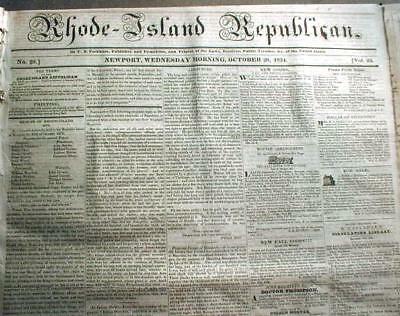-40%
1863 CIVIL WAR newspaper w LARGE MAP of SIEGE of VICKSBURG Grant in Mississippi
$ 23.76
- Description
- Size Guide
Description
1863 CIVIL WAR newspaper with a LARGE MAP of the SIEGE of VICKSBURG-
#1J-026
Please
visit our ebay store for printed on the front page other FANTASTIC Americana, Antiquarian Books and Ephemera.
SEE PHOTO-----COMPLETE, ORIGINAL NEWSPAPER, the
London Illustrated News
(England) dated July 11, 1863, with fantastic FALL of VICKSBURG history!
Perfect for framing and display!
The Vicksburg Campaign was a series of maneuvers and battles in the Western Theater of the American Civil War directed against Vicksburg, Mississippi, a fortress city that dominated the last Confederate-controlled section of the Mississippi River. The Union Army of the Tennessee under Maj. Gen. Ulysses S. Grant gained control of the river by capturing this stronghold and defeating Lt. Gen. John C. Pemberton's forces stationed there.
The campaign consisted of many important naval operations, troop maneuvers, failed initiatives, and eleven distinct battles from December 26, 1862, to July 4, 1863. Military historians divide the campaign into two formal phases: Operations Against Vicksburg (December 1862
– January 1863) and Grant's Operations Against Vicksburg (March–July 1863).
Grant initially planned a two-pronged approach in which half of his army, under Maj. Gen. William Tecumseh Sherman, would advance to the Yazoo River and attempt to reach Vicksburg from the northeast, while Grant took the remainder of the army down the Mississippi Central Railroad. Both of these initiatives failed. Grant conducted a number of "experiments" or expeditions—Grant's Bayou Operations—that attempted to enable waterborne access to the Mississippi south of Vicksburg's artillery batteries. All five of these initiatives failed as well. Finally, Union gunboats and troop transport boats ran the batteries at Vicksburg and met up with Grant's men who had marched overland in Louisiana. On April 29 and April 30, 1863, Grant's army crossed the Mississippi and landed at Bruinsburg, Mississippi. An elaborate series of demonstrations and diversions fooled the Confederates and the landings occurred without opposition. Over the next 17 days, Grant maneuvered his army inland and won five battles, captured the state capital of Jackson, Mississippi, and assaulted and laid siege to Vicksburg.
After Pemberton's army surrendered on July 4 (one day after the Confederate defeat at Gettysburg), and when Port Hudson surrendered to Maj. Gen. Nathaniel P. Banks on July 9, Texas and Arkansas were effectively cut off from the Confederacy, and the Mississippi River was once again open for northern commerce to reach the Gulf of Mexico, and as a supply line for the Union Army. Grant's Vicksburg Campaign is studied as a masterpiece of military operations and a major turning point of the war.
The Illustrated London News founder Herbert Ingram was born in Boston, Lincolnshire, in 1811, and opened a printing, newsagent, and bookselling business in Nottingham around 1834 in partnership with his brother-in-law, Nathaniel Cooke. As a newsagent, Ingram was struck by the reliable increase in newspaper sales when they featured pictures and shocking stories. Ingram began to plan a weekly newspaper that would contain pictures in every edition.
Ingram rented an office, recruited artists and reporters, and employed as his editor Frederick William Naylor Bayley (1808
–1853), formerly editor of the National Omnibus. The first issue of The Illustrated London News appeared on Saturday, 14 May 1842, timed to report on the young Queen Victoria's first masquerade ball. Its 16 pages and 32 wood engravings covered topics such as the war in Afghanistan, the Versailles rail accident, a survey of the candidates for the US presidential election, extensive crime reports, theatre and book reviews, and a list of births, marriages, and deaths. Ingram hired 200 men to carry placards through the streets of London promoting the first edition of his new newspaper.
Costing sixpence, the first issue sold 26,000 copies. Despite this initial success, sales of the second and subsequent editions were disappointing. However, Ingram was determined to make his newspaper a success, and sent every clergyman in the country a copy of the edition that contained illustrations of the installation of the Archbishop of Canterbury, and by this means secured a great many new subscribers.
Its circulation soon increased to 40,000, and by the end of its first year was 60,000. In 1851, after the newspaper published Joseph Paxton's designs for the Crystal Palace before even Prince Albert had seen them, the circulation rose to 130,000. In 1852, when it produced a special edition covering the funeral of the Duke of Wellington, sales increased to 150,000; and in 1855, mainly due to the newspaper reproducing some of Roger Fenton's pioneering photographs of the Crimean War (and also due to the abolition of the Stamp Act that taxed newspapers), it sold 200,000 copies per week.
Very Good condition.
This listing includes the complete entire original newspaper.
VINTAGE BOOKS AND FINE AR
T stands behind all of the items that we sell with a no questions asked, money back guarantee. Every item we sell is original printed on the date indicated at the beginning of its description, unless clearly stated as a reproduction in the header AND text body. U.S. buyers pay calculated priority postage which includes waterproof plastic and a heavy cardboard flat to protect your purchase from damage in the mail. International postage is quoted when we are informed as to where the package is to be sent. We do combine postage (to reduce postage costs) for multiple purchases sent in the same package.
We accept payment by PAYPAL.
W
e ship packages daily.
This is truly a piece OF HISTORY that YOU CAN OWN!












